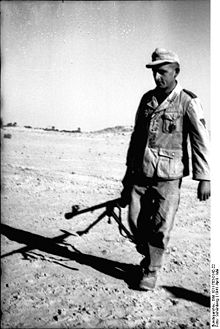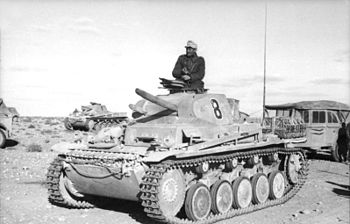- Afrika Korps
-
Deutsches Afrikakorps Active 12 February 1941 – 13 May 1943 Country  Nazi Germany
Nazi GermanyBranch Wehrmacht Heer Type Expeditionary Force Size Corps Garrison/HQ Tripoli, Italian Libya Motto Ritterlich im Kriege, wachsam für den Frieden
("Chivalrous in War, Vigilant for Peace")Colors Yellow, Brown Engagements World War II Commanders Notable
commandersErwin Rommel
Ludwig Crüwell
Walther NehringInsignia Identification
symbol
Identification
symbolSeal of the Deutsches Afrikakorps The German Africa Corps (German: Deutsches Afrikakorps, DAK
 expeditionary force in Libya and Tunisia during the North African Campaign of World War II. The reputation of the Afrika Korps is synonymous with that of its first commander Erwin Rommel, who later commanded the [1] Panzer Army Africa which evolved into the German-Italian Panzer Army (Deutsch-Italienische Panzerarmee) and Army Group Africa, all of which Afrika Korps was a distinct and principal component. Throughout the North African campaign, the Afrika Korps fought against Allied forces until its surrender in May 1943.
expeditionary force in Libya and Tunisia during the North African Campaign of World War II. The reputation of the Afrika Korps is synonymous with that of its first commander Erwin Rommel, who later commanded the [1] Panzer Army Africa which evolved into the German-Italian Panzer Army (Deutsch-Italienische Panzerarmee) and Army Group Africa, all of which Afrika Korps was a distinct and principal component. Throughout the North African campaign, the Afrika Korps fought against Allied forces until its surrender in May 1943.Contents
Organization
The Afrika Korps was derived and formed upon Adolf Hitler's personal choice of Erwin Rommel to its command on 12 February 1941 (Rommel himself landed on African soil in Libya on 14 February 1941 to begin leading his forces that would be brought into action).
The German Armed Forces High Command (Oberkommando der Wehrmacht, OKW) and Army High Command or (Oberkommando des Heeres, OKH) had decided to send a "blocking force" (Sperrverband) to Libya to support the Italian army. The Italian army group had been routed by Commonwealth Force's counter-offensive led by the British Eighth Army, in Operation Compass. The German "blocking force", commanded by Rommel, at first consisted of only the 5./leichte "Afrika" Panzer Regiment, which was quickly cobbled together from the second regiment of the 3./Panzer Division and various other small units attached for water treatment and medical care. These elements were organized into the 5th Light Division when they arrived in Africa from 10 February – 12 March 1941. In late April and into May, the 5th Light Division was joined by transference of the various elements constituting the 15th Panzer Division from Italy, though it did not completely arrive until after Rommel had made a counter-offensive and re-taken most of Cyrenaica and then subsequently gone back over to the defensive. At this time, the Afrikakorps consisted of the two divisions plus various smaller supporting units, and was officially subordinated to the Italian chain of command in Africa (though Rommel had conducted his offensive without any authorization).
On 15 August 1941, the German 5./leichte "Afrika" Division was redesignated 21st Panzer Division (commonly written as 21./PD), still attached to the enlarged entity still known as the Afrikakorps.
During the summer of 1941, the OKW and OKH invested more command structure in Africa by creating a new headquarters called Panzer Group Africa (Panzergruppe Afrika). On 15 August, Panzer Group Africa was activated with Rommel in command, and command of the Afrikakorps was turned over to Ludwig Crüwell. The Panzer Group controlled the Afrikakorps plus some additional German units that were sent to Africa, as well as two corps of Italian units. (A German "group" was approximately the equivalent of an army in other militaries, and in fact, Panzer Group Africa was redesignated as Panzer Army Africa (Panzerarmee Afrika) on 30 January 1942.)
After the defeat at El Alamein and the Allied invasion in Morocco and Algeria Operation Torch, the OKW once more upgraded its presence in Africa by creating the XC Army Corps in Tunisia on 19 November 1942, and then creating a new 5th Panzer Army headquarters there as well on 8 December, under the command of Colonel-General Hans-Jürgen von Arnim.
On February 23, 1943, Panzer Army Africa—now called the German-Italian Panzer Army—was redesignated as the Italian 1st Army and put under the command of Italian general Giovanni Messe, while Rommel was placed in command of a new Army Group Africa (Heeresgruppe Afrika), created to control both the Italian 1st Army and the 5th Panzer Army. The remnants of the Afrikakorps and other surviving units of the 1st Italian Army retreated into Tunisia. Command of the Army Group was turned over to von Arnim in March. On 13 May, remnants of the Afrikakorps surrendered, along with all other remaining Axis forces in North Africa.
Composition and terminology
"Afrika Korps" is derived from the original German name properly written as one word. Strictly speaking, the term refers to the original formation which, although not dissolved, became part of the ever-expanding German and Italian presence in North Africa for its February 1941–May 1943 role in the North African Campaign. However, it is sometimes used by the news media and veteran Allied soldiers as a name for all the German units in North Africa. Some notable attached units include the 15th Panzer Division, 21st Panzer Division, Afrika zbV (zur besonderen Verwendung, "special purpose") Division, which was created as an infantry division and slowly upgraded to a fully motorized division, and then redesignated as the 90th Light Afrika Division; the 164th Light Afrika Division, the 999 Light "Afrika" Division, also the 334th Infantry division; and the Luftwaffenjäger-Brigade 1 or Fallschirmjäger-Ramcke Brigade Ramcke Parachute Brigade (named after its commander Hermann-Bernhard Ramcke). There were also eight Italian divisions (out of the 10 Italian Divisions in North Africa) under Rommel's command in Panzer Army Afrika, including two armored divisions, two motorized divisions, three infantry divisions, and the Folgore parachute division. The army was supported by a number of smaller units from both the German and Italian armed forces.
The designation "Light" (German: Leicht) did not refer to a standardized table of organization and equipment (TOE) for the various German divisions that bore that designation.
German unit organizations were based on tables of organization, (Kriegsstärkenachweisungen, or KStN). Every unit in the German Army raised had one, and all orders raising units indicated the corresponding KStN number and date which applied to them. For instance, the 5./leichte "Afrika" or 5th Light "Africa" had an organizational structure that was missing specific elements to make it a complete Panzer "Division", as did its late April to May 1941 arriving "full complement" partner division in Africa, the 15./Panzer Division. The 5./le. "Africa" Division eventually became at least partially expanded into the 21./PD or 21st Panzer Division. It was given German unit elements that were already on the ground in North Africa and some replacement equipment to meet the prescribed full Panzer Division KStN constraints (except for the Motorcycle Battalion component, which was never complete) and then renamed in August 1941. As the entire Afrikakorps organization was restructured and even renamed in August 1941, the nomenclature of Afrikakorps lasted less than six months. The famous force, with the short-lived name Afrikakorps, became a major German component of Panzer Army Africa; Panzerarmee Afrika, which evolved into the German-Italian Panzer Army (Deutsch-Italienische Panzerarmee) and then to Army Group Africa (Heeresgruppe Afrika) in the 27 months of the campaign for this force.[citation needed]
Additional German forces were sent to Africa and became components of the Panzer Army Africa, Panzerarmee Afrika. Examples such as the 164./le. "Africa" or 164th Light Afrika Division was at first only a partially-motorized infantry division, and actually never had any tanks at all, only armored cars and reconnaissance vehicles. Various German divisions in Africa occasionally reorganized or re-equipped without a change of name, or conversely were redesignated with a new name without any substantial reorganization. None of the German Armies actually fielded for service in North Africa completely met the service KStNs directed for their completion because of battle losses, sinkings across the Mediterranenan while in transit and the tremendous wear on the vehicles.
Hermann Göring Panzer Division
Luftwaffe Fallschirmjäger (paratroopers) from FJR3 and FJR5 of the Hermann Göring Panzer Division, plus ground and mechanized forces were sent to Tunisia beginning in mid-November 1942 and through to major components into March 1943. Over 5,000 from this force were buried in the Cape Bon Peninsula, Tunisia.
Ramcke Brigade
The Luftwaffenjäger-Brigade 1, known more commonly as the Ramcke Parachute Brigade, worked alongside the Afrika Korps after Operation Hercules (the planned invasion of Malta) was cancelled and the Brigade was subsequently re-deployed to Germany.
Internment in Mississippi
Thousands of Korps POWs were held in camps at Camp Shelby in Mississippi after their capture.[2]
Resurrection of units
Certain divisions were resurrected in Europe after the cessation of fighting in Tunisia:
- 15./Panzer Division
- 21./Panzer Division (in France)
- Hermann Göring Panzer Division (in Sicily and Italy)
Afrika Korps marching songs
1st song: Panzer rollen in Afrika vor / Heiß über Afrikas Boden
Heiß über Afrikas Boden die Sonne glüht.
Unsere Panzermotoren singen ihr Lied!
Deutsche Panzer im Sonnenbrand,
Stehen zum Kampf gegen England
Es rasseln die Ketten, es dröhnt der Motor,
Panzer rollen in Afrika vor!Translation
The sun shines hot over African ground.
Our panzer engines are singing their song!
German panzers in the blazing sun,
As they stand ready for battle against England.
The tracks rattle, the engine roars,
Panzers rolling forwards in Africa.2nd Song: "Unser Rommel" ("Our Rommel")[3]
1.
Wir sind das deutsche Afrikakorps
Des Führers verwegene Truppe
Wir stürmen wie die Teufel hervor
Versalzen dem Tommy die Suppe
Wir fürchten nicht Hitze und Wüstensand
Wir trotzen dem Durst und dem Sonnenbrand
Marschieren beim Takt unserer Trommel
Vorwärts, vorwärts
|:Vorwärts mit unserem Rommel!:|Translation of verse 1
We are the German Africa Korps
The Führer's daring troops
We attack like the Devil
Make things hot for the Tommys
We fear neither heat nor desert sand
We brave the thirst and the blazing sun
Marching to the beat of our drum
Forwards, forwards
|:Forwards with our Rommel!:|2.
Die Briten fürchten uns wie die Pest
Sie sitzen auf glühenden Kohlen
Wir rächen Deutsch-Ost und rächen Südwest
Das einst sie uns feige gestohlen
Sind Churchill und Roosevelt auch Wut entbrannt
Wir werfen die Feinde in jedem Land
Es schlägt Generalmarsch die Trommel
Vorwärts, vorwärts
|:Vorwärts mit unserem Rommel!:|Translation of verse 2
The British fear us like the plague
They're like cats on a hot tin roof
We're taking revenge for German East (Africa) and for South-West (Africa)
Which were cowardly stolen from us
Churchill and Roosevelt are getting mad
We beat the enemy in every country
The drum beats 'get ready'[Note 1]
Forwards, forwards
|:Forwards with our Rommel!:|3.
Mit uns im Kampf und im Siege vereint
Marschieren Italiens Scharen
Bis einst die Sonne des Friedens uns scheint
Und wieder gen Deutschland wir fahren.
Doch wenn mich die feindliche Kugel fand
So lasset mich ruhen im Wüstensand
Und rühret noch einmal die Trommel
Vorwärts, vorwärts
|:Vorwärts mit unserem Rommel!:|Translation of verse 3
With us united in battle and in victory
Italy's cohorts are marching
Until one day the sun of peace will shine on us
And we will return to Germany.
But if the enemy's bullet gets me
Then let me rest in the desert sand
Let the drum beat once more.
Forwards, forwards
|:Forwards with our Rommel!:|See also
- Army Group Africa
- Erwin Rommel
- Panzer Army Africa
- Fliegerführer Afrika
- Western Desert Campaign
- North African Campaign
- First Battle of El Alamein (1–27 July 1942)
- Second Battle of El Alamein (23 October – 4 November 1942)
- László Almásy
- Operation Salaam
- Hans von Luck
- Hans-Jürgen von Arnim
- Panzer Division
- Afrika Korps (game)
- Heer
- Eastbourne Redoubt, home of General Hans-Jürgen von Arnim's Steyr 1500A Africa Korps Staff Car
Notes
- ^ A German military signal meaning: "Attention! Assemble at your positions!"
References
- ^ With Rommel in the Desert by Heinz Werner Schmidt
- ^ "I Was There When It Happened", Jimmy Lee Beasley. Xlibris Corporation, 2010. ISBN 1453544577, 9781453544570. p. 262
- ^ Song text and MP3(not identical at the ending of the third verse) of Unser Rommel Retrieved 2007-02-12
- Cooper, Matthew (1990). The German Army 1933–1945. Scarborough House. Chelsea, MI, USA. ISBN 0-8128-8519-8.
- von Mellenthin, Major General F. W. (1971) [1956]. Panzer Battles: A Study of the Employment of Armor in the Second World War (First ed.). New York: Ballantine Books. ISBN 0-345-24440-0.
- AFRIKAKORPS.org/AANA Research Group
- Rommel's Kampfstaffel
Further reading
- Editor Major-General Alfred Toppe Desert warfare:German experiences in World War II, written with the assistance of nine German commanders who served in North Africa, the manuscript (translated by Mr. H. Heitman) represents a collaborative attempt to determine "as many factors as possible which exerted a determining influence on desert warfare."
- Hans von Luck's memoirs Panzer Commander: The Memoirs of Colonel Hans von Luck include chapters from his time in North Africa under Rommel.
External links
- Afrika Korps History[dead link]
- Panzer-Armee "AFRIKA" Kommandeurs[dead link]
- Knight's Cross of the Iron Cross Holders: North Africa[dead link]
- Rommel's Kampfstaffel[dead link]
- Afrika Korps Uniforms[dead link]
- Unser Rommel - Wir sind das deutsche Afrikakorps - in MP3 format
- Deutsches Historisches Tonarchiv - see "Lieder und Märsche des Afrika Korps" (Commercial site with songs available on CD)
German Army (Heer) Corps of the Wehrmacht Army Corps
ArmeekorpsI. · II. · III. · IV. · V. · VI. · VII. · VIII. · IX. · X. · XI. · XII. · XIII. · XIV. · XV. · XVI. · XVII. · XVIII. · XIX. · XX. · XXI. · XXII. · XXIII. · XXIV. · XXV. · XXVI. · XXVII. · XXVIII. · XXIX. · XXX. · XXXII. · XXXIII. · XXXIV. · XXXV. · XXXVIII. · XXXIX. · XXXX. · XXXXI. · XXXXII. · XXXXIII. · XXXXIV. · XXXXVI. · XXXXVII. · XXXXVIII. · L. · LI. · LII. · LIII. · LIV. · LV. · LVII. · LIX. · LXII. · LXIII. · LXIV. · LXV. · LXVI. · LXVII. · LXVIII. · LXIX. · LXX. · LXXI. · LXXII. · LXXIII. · LXXIV. · LXXV. · LXXVI. · LXXVIII. · LXXX. · LXXXI. · LXXXII. · LXXXIII. · LXXXIV. · LXXXV. · LXXXVI. · LXXXVII. · LXXXVIII. · LXXXIX. · LXXXX. · LXXXXI. · LXXXXVII.
Tank Corps
PanzerkorpsIII. · IV. · VII. · XIV. · XXIV. · XXXVIII. · XXXIX. · XXXX. · XXXXI. · XXXXVI. · XXXXVII. · XXXXVIII. · LVI. · LVII. · LVIII. · LXXVI. · Feldherrnhalle · Großdeutschland
Mountain Corps
GebirgskorpsXV. · XVIII. · XIX. · XXI. · XXII. · XXXVI. · XXXXIX. · LI.
Cavalry Corps
KavalleriekorpsI.Miscellaneous Corps Afrika KorpsCategories:- Corps of Germany in World War II
- German units in Africa
- Military units and formations established in 1941
Wikimedia Foundation. 2010.



